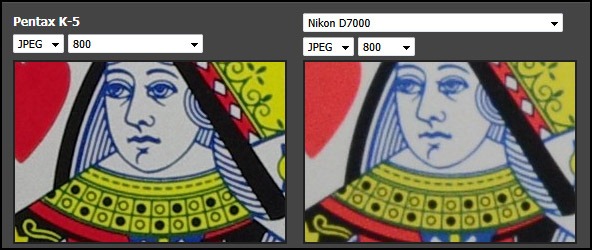Digital Noise: Pentax K-5 vs. Nikon D7000
In a recent post I covered how dpreview.com rated the Pentax K-5 higher than the Nikon D7000. While the K-5 rated higher than the D7000 in almost all tests one test where it rated significantly higher was digital noise handling.
Digital Noise
Digital noise is that annoying speckling and fuzziness that you get on digital photographs when you take low light photographs or if you push the ISO setting up too high. With most modern semi-pro DSLRs if you select an ISO setting over 400 you can expect to get noticeable digital noise occurring. However as digital sensors get better and the in-camera software gets smarter at removing digital noise ISO settings of 800 and even 1600 start to become useable.
With the Pentax K-5 pictures taken using an ISO of 1600 are considered useable, and with a little post-processing noise removal (using a tool like Noise Ninja), even ISOs of 3200 and 6400 can be considered before the digital noise becomes a concern.
The following screen captures from the dpreview.com site compares pictures taken by the K-5 to the D7000 at ISOs of 800, 1600, and 3200.
While the K-5 picture is starting to get fuzzy and speckled at ISO 3200 (the last example above) it is significantly better than the D7000 where the blacks are going noticeably grey-ish and colours are starting to wash out.
I can hear some readers—those into photography—saying “So what! Who shoots at ISO 3200?”.
There are two sorts of people who use ISOs of 800, 1600, and 3200, and higher even.
Green mode: The first group are people who use their cameras on ‘green’ mode and have no idea what ISO the camera is using to take the picture—the camera’s computers just ‘automatically’ wind up to the ISO required to get the shot taken as they push the button.
One might think that anyone who has paid out good money ($1,500+) to buy a camera like a K-5 or a D7000 would never ever use ‘green’ (fully automatic) mode, but I have seen research that indicates up to a third of semi-pro DSLR buyers flick to ‘green’ mode more than half the time. Often when I am checking out photographs on Flickr or PhotoSig or SmugMug and I check the Exif data it says “Auto mode” indicating the shot was taken in ‘green’ mode.
Small aperture: The second group are photographers who, for one reason or another, want or need to use a high f-stop (small aperture) setting, or don’t have a lens with a low enough aperture setting to avoid using an ISO higher than the ‘safe’ upper limit of 400. As a rule of thumb the cost of lenses increases as the size of the aperture increases. A good 85mm wide aperture lens easily gets past $,1000.
So to overcome the lack of aperture size you can wind up the ISO, and with the K-5 you are reasonably safe winding it up to 1600 and maybe 3200 (depending on the picture you are taking).
Or maybe depth-of-field is more important that a trace of digital noise so you particularly want to use f22 for a certain picture like a close up of a flower and you want as much of the flower to be in focus as possible. In such cases being able to slide the ISO as high as 3200, or maybe even 6400 (see below), can come in very useful.
Following is the comparison at 12,800 ISO for any masochistic photographers reading this .
I am afraid even the picture from the K-5 is pretty well beyond saving at 12,800 ISO. But then, if you spotted Jessica Alba bathing topless in the half-light and you had to snap on your 800mm f8 lens to get the shot using ISO 12,800 then I would rather the picture quality on the left to the D7000 on the right.
[All pictures link back to the Studio Scene Comparison page for the Pentax K-5 at the dpreview.com site. Use Ctrl+Click to open dpreview.com in a new Tab]






